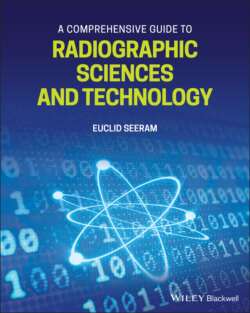Читать книгу A Comprehensive Guide to Radiographic Sciences and Technology - Euclid Seeram - Страница 21
Computed tomography – physics and instrumentation
ОглавлениеThis section will present a broad overview of the essential elements of the Physics and Instrumentation of Computed Tomography. One of the major advantages of CT is that it provides improved contrast resolution compared to radiography and for this reason, it has proven to be worthy of further developments in imaging soft tissues of the human body. It is important to note, however, that magnetic resonance imaging (MRI) has superior contrast resolution compared to all other imaging modalities, such as radiography, nuclear medicine, and diagnostic medical sonography.
CT is a sectional imaging technique that produces direct cross‐sectional digital images referred to as transverse axial images which has been referred to as planar sections that are perpendicular to the long axis of the patient. The word “computed” implies that a computer is used to process and reconstruct x‐ray transmission data collected from the patient. The CT scanner has evolved from single‐slice CT scanners (SSCT) to multi‐slice CT scanners (MSCT). State‐of‐the‐art CT scanners are now MSCT scanners capable of a wide range of applications. The increasing use is that CT in clinical practice has led to increasing doses to the patient and a well‐documented fact is that CT delivered the highest collective dose in the United States compared to other medical imaging modalities.
Two individuals shared the Nobel Prize in Medicine and Physiology in 1979 for their development of the CT scanner. These include Godfrey Newbold Hounsfield in the United Kingdom (UK) who invented the first clinically useful scanner, and Allan Cormack, a physicist at Tufts University in Massachusetts.
CT is a multidisciplinary technology and has its roots in physics, mathematics, engineering, and computer science. The CT process consists of at least three major system components that are used to produce the CT image; the data acquisition system; the computer system; and the image display, storage, and communication systems.
Data acquisition means that radiation attenuation data are collected from the patient during the scanning. In this respect, an x‐ray tube coupled to special electronic detectors rotate around the patient to collect and measure attenuation readings as the x‐ray beam passes through the patient.
The attenuation is according to Beer–Lambert's law:
where I is the transmitted x‐ray beam intensity, Io is the original x‐ray beam intensity, e represents Euler's constant, μ is the linear attenuation coefficient, and Δx is the finite thickness of the section. In CT, the system calculates all μs for all structures seen on the image. Special detectors and detector electronics are used to calculate the attenuation data and convert them into integers (0, a positive number, or a negative number) referred to as CT numbers using an image reconstruction algorithm to build up the image in numerical format. The CT numbers (numerical image format) are converted into a gray‐scale image for display on a monitor for the observer to interpret.
The CT numbers are calculated using the following relationship:
where K represents a scaling factor. In general, K is equal to 1000. When Hounsfield invented the scanner, K was equal to 500.
The technology aspects of CT are complex and are responsible for using the attenuation values collected around the patient for 360° to build up an image of the internal anatomy of the patient, and displays such image for interpretation by radiologists. The technology addressing the collection of these values includes the x‐ray tube which is coupled to special electronic detectors and detector electronics. Another major technology component in CT is the computer system which captures the raw data from the detectors and uses sophisticated image reconstruction algorithms for creating the image from the raw data.
Present‐day CT scanners are MSCT scanners. One characteristic feature of MSCT is the two‐dimensional detector array, compared to a one‐dimensional detector array of SSCT. This means that there will be additional specific technical factors that affect the dose in CT. One such notable factor is the pitch (P), which is defined by the International Electrotechnical Commission (IEC) as the distance the table travels per rotation (D) divided by the total collimation (W). This can be expressed algebraically as:
The increasing use of CT has led to widespread concerns about high patient radiation doses from CT examinations relative to other radiography examinations. The distribution of the dose to the patient in CT is significantly different than the distribution of the dose in radiography. These differences require additional CT‐specific dose metrics. There are essential four CT‐specific dose metrics: the computed tomography dose index (CTDI), the dose length product (DLP), the size‐specific dose estimate (SSDE), and the ED. These and other elements of CT physical principles will be described further in Chapter 7.
